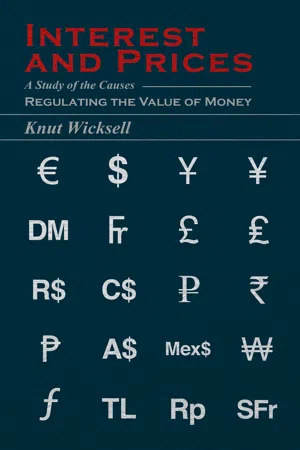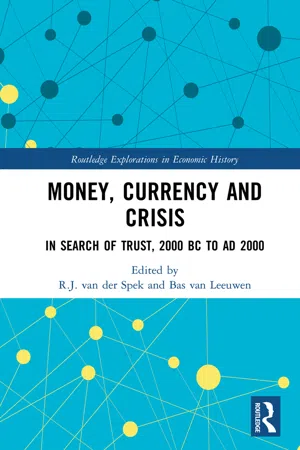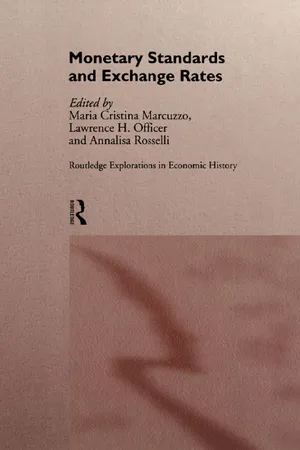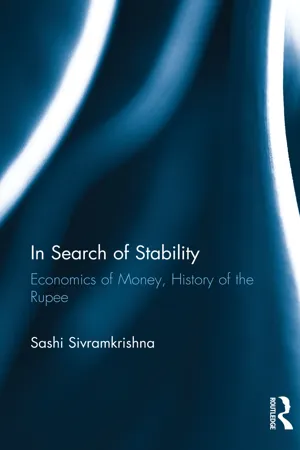Economics
Bimetallic Standard
A bimetallic standard is a monetary system where the value of the currency is based on the fixed relationship between two different metals, typically gold and silver. This system allows for the circulation of both metals as legal tender, with the value of the currency being determined by the fixed exchange rate between the two metals.
Written by Perlego with AI-assistance
Related key terms
9 Key excerpts on "Bimetallic Standard"
- eBook - ePub
Money Mischief
Episodes in Monetary History
- Milton Friedman(Author)
- 1994(Publication Date)
- Mariner Books(Publisher)
Chapter 6 Bimetallism Revisited * Throughout recorded history, monetary systems have generally been based on a physical commodity. Metals have been the most widely used, the precious metals of silver and gold above all. As between them, “silver composed nearly the entire circulating metallic currency of Europe” until at least the late nineteenth century (Martin 1977, p. 642), and also of India and other parts of Asia. Gold was used much less, primarily for high-valued transactions. The rate of exchange between silver and gold was sometimes specified by the authorities, sometimes left to the market. If a legal rate was specified, the result was a bimetallic system (as described in chapter 3) under which an authorized mint stood ready, for anyone who requested it to do so, to turn either silver or gold into coins of designated face value and specified weight and fineness on demand (free coinage). Typically there was a small seignorage charge to cover the cost of minting, though sometimes, as in Great Britain and the United States, there was none. The legal price ratio was determined by the weights assigned to the silver and gold coins. For example, from 1837 to the Civil War, the U.S. gold dollar was defined as equal to 23.22 grains of pure gold, the silver dollar as equal to 371.25 grains of pure silver—or 15.988 times as many grains of silver as of gold, rounded in common parlance to a ratio of 16 to 1. A strictly equivalent way to define a Bimetallic Standard is in terms of a government commitment to buy either gold or silver at a fixed price in money designated as legal tender. For the U.S. example, the corresponding fixed prices were $20.67 per fine ounce of gold and $1.29 per fine ounce of silver. * That remained the legal price of gold until 1933, when President Franklin D. Roosevelt raised it by stages and then fixed it at $35 an ounce in early 1934. There it remained until it was raised to $42.22 in early 1973, the price at which the gold holdings of the U.S - eBook - ePub
Battles for the Standard
Bimetallism and the Spread of the Gold Standard in the Nineteenth Century
- Ted Wilson(Author)
- 2017(Publication Date)
- Routledge(Publisher)
In wartime it was not possible to retain commodity convertibility, that is, to keep the currency on a standard, because of the exigencies of war itself: the inevitable shortage of specie which was used to pay for essential matériel, the need to expand the money supply to pay for the war effort in general, and so on. So commodity standards broke down in wartime. But the intention – apart perhaps from the French creators of the assignats and mandats of the revolutionary period – was always to return to convertibility of some kind as soon after the end of the war as possible. Commodity moneys, then, were the general rule and almost all monetary authorities based their currencies on either gold or silver, or both. Where both precious metals were used we often use the term ‘bimetallism’ or ‘dual standard’ to describe them. But therein lies a problem. The term bimetallism is to a large extent governed by the context in which it is used. It has been taken to mean, variously: an ancient system of currency long outdated and discredited; a monetary regime tirelessly promoted by the French in the nineteenth century against the good sense of England and the gold standard; a pitiful nostrum advocated by economic cranks to reverse the worst effects of the ‘Great Depression’ of 1873–96; or a synonym of, if not euphemism for, the American populists who advocated the restoration of silver as an easy means of raising primary-product prices in the Midwest during the late nineteenth century. We shall see also that in a formal sense there are several different kinds of bimetallism according to the geographical extent to which advocates believed the dual standard should be extended and according to what kind of metal ratio (between gold and silver) should be pursued. These varieties of bimetallism are clearly identifiable in economic history but, unfortunately, have never been adequately delineated or labelled either by contemporaries or by historians - eBook - ePub
- John Roscoe Turner(Author)
- 2019(Publication Date)
- Routledge(Publisher)
A knowledge of Gresham's law introduces a discussion of bimetallism, for the operation of this law will maintain a fixed ratio between the purchasing powers of gold and silver. Should either metal become cheaper debtors will be eager to pay with it. This will at once increase the demand for the cheaper and lower the demand for the dearer metal, thereby making them equal.5. Bimetallismmeans the free coinage of two metals at a fixed ratio, the coins of either being legal tender as the debtor may elect. Monometallism is a monetary system where one metal is given the right of free coinage. Bimetallism as well as monometallism may be thought of as a single standard. Two metals maintained at a parity perform precisely the same functions; they lose their independence in a monetary sense and become one and the same. A country may have the Bimetallic Standard based on gold and silver, and coin other metals, as copper and nickel. Coins of other metals, however, are token and not primary money.The common man of this generation thinks of bimetallism as a mere theory—-something nice to talk about but dangerous and unworkable if established. He is not informed that mankind has had far more experience and, may I add, more satisfactory experience with bimetallism than with monometallism and that prior to the nineteenth century no nation definitely adopted monometallism, England broke the rule in 1816, but neither the United States nor European nations followed her example until after 1870. Bimetallism is workable and it is not involved in mystery as many are led to believe. It rests upon a single definite and simple principle which explains the extraordinary permanence of the ratio of exchange of gold and silver under bimetallism.6. The compensatory principleis the fundamental fact In bimetallism. This principle recognizes two great demands for both gold and silver; their use in the arts and in the coinage of money. The monetary demand is large and any change in it reacts quickly upon the purchasing power of these metals. This very fact—the quick and sensitive response of the purchasing power of these metals to changes in demand—makes ft impossible for either gold or silver, under bimetallism, to fall much below the other, and impossible for them to remain separate in price. After the gold discoveries in California and Australia, John E. Cairnes, the eminent English economist, wrote (and I give this illuminating quotation, because it shows the nature of the compensatory principle): "The crop of gold has been unusually large; the increase in the supply has caused a fall in its value; the fall in its value has led to its being substituted for silver; a mass of silver has thus been disengaged from purposes which it was formerly employed to serve; and the result has been that the two metals have fallen in value together." If, according to Gresham's law, gold tends to drive silver out, less silver and more gold will be used in coinage. This decrease in the demand for silver will lower its purchasing power; this increase in the demand for gold will increase its purchasing power; the result will be a coming together of the two. This interaction of the forces of supply and demand which maintains a fixedness of the ratios between gold and silver is known as the compensatory principle. - Knut Wicksell(Author)
- 2011(Publication Date)
- Josephs Press(Publisher)
We are told that if two commodities are employed as a measure of prices, their value in conjunction must be more stable than of either taken separately. That may be true, but it is improper to proceed by way of the “Law of Large Numbers” when it is a question purely of the transition from the number one to the number two. Circumstances can easily arise under which the Bimetallic Standard of prices would be less stable than gold. Let us imagine—what is, after all, not unthinkable—that we have now reached the lowest point of the downward movement of prices, and that the continual production of gold and the excess of bank reserves must necessarily tend to depress the money rate of interest and force up prices. In the immediate future, however, fairly stable prices might be attained, inasmuch as new countries, such as Austria, Russia, 1 and perhaps finally India, may turn over to gold coinage. But the introduction of bimetallism, even at a moderate ratio, would under such conditions bring about a continual, and perhaps very considerable, rise in prices, with all the associated disadvantages. The same essential considerations apply to the “composite standard” or “symmetalism” proposed by Marshall, Edgeworth, and others. Under this system, a country’s, or the world’s, coinage would consist of a mixture in certain proportions of gold and silver. The system would not even have the merit of avoiding fluctuations in the rate of foreign exchange with silver countries. L. Walras has proposed a method, 2 not really bimetallism at all, which theoretically is less objectionable. He would maintain the use of gold as a standard, and he would not permit the free coinage of silver; but silver is to be used as a billon régulateur, the size of the stock of monetary silver being managed according to circumstances, with the object of achieving the highest possible degree of constancy of the value of money in terms of commodities- eBook - ePub
- Thomas Sargent, François Velde(Authors)
- 2014(Publication Date)
- Princeton University Press(Publisher)
7 be fixed by the rules of bimetallism. But in 1873, France and the United States both ended the free coinage of silver. The ensuing fall in the market value of silver promptly made their existing silver coins into overvalued tokens, for which convertibility was ultimately provided.To understand why this happened, we briefly review two theories of bimetallism, the first of which assumes that relative prices of silver and gold are exogenous (a “small country” assumption), the second of which makes relative prices of gold and silver respond to the choice of monetary regime of a government or a coalition of governments.Bimetallism in a small countryThe model of chapter 11 can be used to study bimetallism for a small country that takes relative prices of gold and silver to be exogenous. Bimetallism adds to the chapter 11 model a government rule that makes gold and silver coins legal tender at a fixed ratio.However, if there are frequent and substantial changes in the relative prices of the metals in terms of consumption goods (φg , φs ), it is difficult to sustain a fixed exchange rate for very long in the model of chapter 11 . To maintain concurrent circulation of coins of both metals in the face of such changes, the government has to adjust coin specifications (i.e., debase or reenforce coins of one of the metals) to realign the intervals.Appreciations in φs and φg have very different ramifications for potential shortages of small change. An increase in the price of goods in terms of silver, φs , (a cheapening of silver) shifts the silver interval to the right and ultimately leads to minting of silver and melting of gold. At worst, all currency becomes silver, which leads to no shortages of the small denomination silver coins. But an increase in the gold price of goods, φg - eBook - ePub
Money, Currency and Crisis
In Search of Trust, 2000 BC to AD 2000
- R.J. van der Spek, Bas van Leeuwen(Authors)
- 2018(Publication Date)
- Routledge(Publisher)
If a divergence occurred, for example because the discovery of new mines of gold made gold cheaper against silver, and if the legal ratio remained unchanged, it would be convenient to purchase silver coins at the legal ratio, melt them, and with the same weight of silver in bullion, to buy on the market a higher quantity of gold coins. The idea that substitution between monetary and non-monetary uses of gold and silver would bring the market ratio of gold to silver again into equilibrium with the Mint ratio clashed with actual experience. Coins of the appreciating metal would disappear from circulation (the ‘Gresham law’), 10 and the only standard – that is, the only metal used as money – would be the depreciated currency (gold, in our example). The double standard – bimetallism – would make place for the single standard – monometallism. The second issue is related to the fact that the use of gold coins is totally impractical for retail transactions, so that a single standard would generate an unsatisfied want of small coins. John Stuart Mill praised the ‘considerable perfection’ of bimetallism, but added that this system left an open question regarding the ‘mode’ in which smaller payments could be carried out: ‘Though the qualities necessary to fit any commodity for being used as money are rarely united in any considerable perfection, there are two commodities which possess them in an eminent, and nearly an equal degree: the two precious metals, as they are called: gold and silver […]. There is an obvious convenience in making use of the more costly metal for larger payments, and the cheaper one for smaller; and the only question relates to the mode in which this can best be done’. 11 Silver coins were too heavy also for small payments. The solution, the ‘mode’, was found by issuing silver coins at a premium over their metal content, that is, with a face value higher than their intrinsic silver value - eBook - ePub
- Maria Cristina Marcuzzo, Lawrence H. Officer, Annalisa Rosselli(Authors)
- 2002(Publication Date)
- Routledge(Publisher)
de jure); France was on bimetallism; and the Northern European countries were on the silver standard. These zones had their respective centres in London, Paris and Hamburg, where three key currencies were freely exchanged: the pound sterling, the franc and the mark (or the schilling, before 1828). And finally, there was in each of these zones, side by side with the circulation of specie, a circulation of banknotes convertible into specie; exceptional (though persistent) circumstances even led to the inconvertibility of Bank of England banknotes.These characteristics make the period in question an interesting subject for a historical study for at least three reasons. First of all, there were fundamental debates going on at the time about the theory of money and exchange, and the effects on the exchange of the existence of two standards instead of one were variously understood. For Tooke, the comparison between a country with a monometallic standard and a country with a bimetallic one shows that the movements of the exchange with a third country (whatever its standard) are always larger in the latter one (Tooke 1848, 3:217). Goschen maintains that the movements of the exchange rate between a country with a monometallic standard and a country with a bimetallic one are circumscribed to a band determined by the standard they have in common (Goschen 1861:82). Juglar states that the band of exchange variations of a country with a Bimetallic Standard is narrower against a country with a monometallic standard than against a country with a bimetallic one (Juglar 1874:211). Our analysis will cast doubts on the rightness of these opinions.A second reason to study that period is to put in a different perspective the accepted theories on exchange rates under a metallic standard, which were chiefly influenced by the observation of the generalized gold-standard period after 1873.2 And third, the study of this tripolar international monetary system may contribute to a more detailed analysis of monetary and exchange regimes.3We shall limit our present investigations to the state of exchange between London and Paris from 1796 to 1873. To our knowledge, there exist no published series of prices of precious metals and exchange rates in London and Paris that appeared more than once a week, as would be required for the analysis of the adjustment processes. We therefore had to construct these long series on the basis of the original data. The first results of our analysis were published in Boyer-Xambeu, Deleplace and Gillard (1994b). In Boyer- Xambeu, Deleplace and Gillard (1995), we publish these figures with detailed commentaries.4 - eBook - ePub
In Search of Stability
Economics of Money, History of the Rupee
- Sashi Sivramkrishna(Author)
- 2016(Publication Date)
- Routledge(Publisher)
the rate between them determined by the market ; a currency system called a parallel standard. But this system had a limitation; in a market with constant fluctuations in the exchange rate between gold and silver one could end up incurring losses unless the variations were fully known. The more appropriate alternative it seemed was bimetallism where both metals could circulate as coin but with the government fixing the rate (or ratio) of exchange between them.Using Irving Fisher’s (1912) articulation of gold and silver money as ‘substitutes, but have no natural ratio of substitution’ (p. 377) I have tried to describe these currency systems graphically using a simple demand-supply model. While supply of money is considered fixed at a point of time, the demand curves will typically be downward sloping. This is because as price of one metal falls with respect of the other it will be substituted for the other at least in the arts (non-monetary usages). Whether it will also be substituted for the other as money depends on whether a parallel standard or bimetallism is in existence. Consider Country CP on a parallel standard where both gold and silver circulate as money at an exchange rate determined by the market. The gold and silver bullion markets are at equilibrium with demand equal to supply at (say) G/S = 15, i.e. 1G = 15S or S/G = 1/15 as shown in Figure 1.3 (a) and 1.3 (b) respectively. Suppose gold supply increases from SG to SG ’. This would put pressure on the silver price of gold to fall from 15 towards (say) 14 as the excess supply gets absorbed for non-monetary purposes. But will substitution of silver money by the cheaper gold take place? Suppose a cup of tea had cost 1G = 15S before gold prices fell to 14S. If gold is the accepted unit of account, then the price of tea remains at 1G so that you pay either 1G or 14S for it. If instead silver is the unit of account, the tea price remains at 15S so you must pay either 15S or 1.07G (as per the new rate of 1G = 14S) for it. Gold will not replace silver as coin. However, as shown in Figure 1.3 (a), the fall in the silver price of gold would result in an increase in quantity demanded of gold from G0 to G1 - eBook - ePub
Economists in Parliament in the Liberal Age
(1848–1920)
- Marco E.L. Guidi, Massimo M. Augello(Authors)
- 2017(Publication Date)
- Routledge(Publisher)
Worthy of note, in this regard, is his article commenting on a gathering of the Bimetallic League held in Manchester in April 1988. It was Taguchi’s contention that British cotton manufacturers, seeking to recoup the losses they had suffered in the wake of destruction of the stable exchange rate between gold and silver, were aiming to raise general prices by depreciating the value of their currency. 29 Yet such a move, Taguchi claimed, totally failed to take into account that the purpose of the Bimetallic Standard lay in stabilising general prices. Taguchi espoused a conception of bimetallism that contrasted with an inflationist point of view: ‘Economists in the European gold standard countries advocate the international Bimetallic Standard for the fear of a further decline of prices. But I commit myself to the international Bimetallic Standard to avoid the rise of rice price produced by an anticipated further decline of silver price’. 30 As the price of rice formed the general basis for prices in Japan at that time, what Taguchi most greatly feared was that the decline in the price of silver would trigger a rise in general prices driven by an increase in the price of rice. He was convinced that raising prices due to currency depreciation would eventually destroy the economic equilibrium. To avert such a risk and achieve stabilisation of the economy, he believed the most appropriate measure would be the adoption of a bimetallic monetary system. Although this recommendation might seem implausible to staunch advocates of the gold standard, Taguchi remained firmly convinced that the gold standard constituted a system that would destroy the balanced economic order that was essential if free trade was to flourish and produce the greatest benefits of its functioning
Learn about this page
Index pages curate the most relevant extracts from our library of academic textbooks. They’ve been created using an in-house natural language model (NLM), each adding context and meaning to key research topics.








